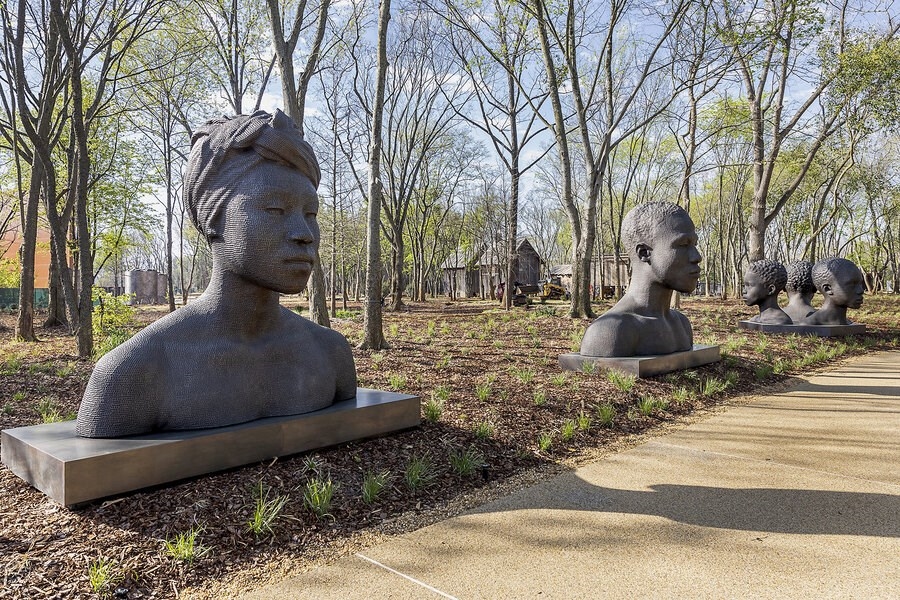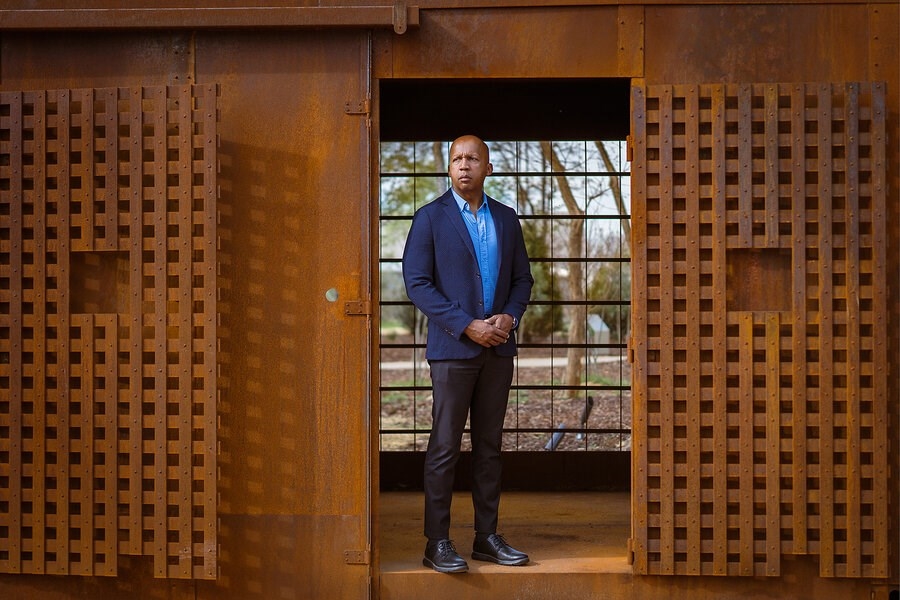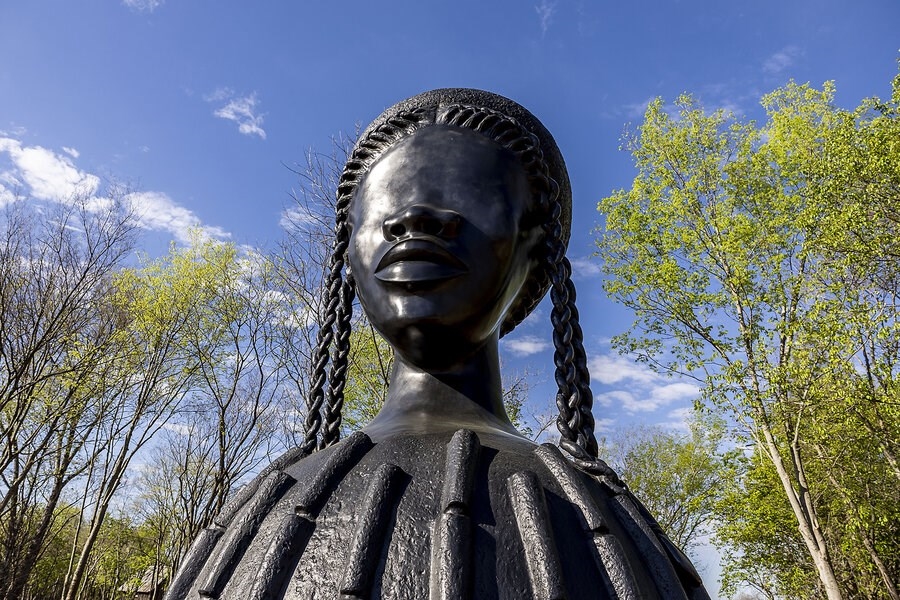REPRINTED WITH PERMISSION FROM THE CHRISTIAN SCIENCE MONITOR
“What kind of art would help people understand this history?” Bryan Stevenson says he asked himself before creating the new Freedom Monument Sculpture Park in Montgomery, Alabama.
 The recently opened Freedom Monument Sculpture Park in Montgomery, Alabama, includes Black Renaissance, a trio of bronze busts by artist Rayvenn D’Clark. Vasha Hunt/AP
The recently opened Freedom Monument Sculpture Park in Montgomery, Alabama, includes Black Renaissance, a trio of bronze busts by artist Rayvenn D’Clark. Vasha Hunt/AP
How should the story of slavery in the United States be told?
In Montgomery, Alabama – once a major trafficking port for enslaved people – a new 17-acre park with a focus on art is attracting thousands of visitors. Freedom Monument Sculpture Park, opened in late March, features bronze sculptures and historical artifacts that highlight what life was like for enslaved people. The park culminates in the four-story National Monument to Freedom, inscribed with 122,000 last names that formerly enslaved people chose for themselves after being emancipated.
The sculpture park is the third Legacy Site created by the Equal Justice Initiative, a legal advocacy organization started by Bryan Stevenson, a lawyer perhaps best known for his memoir and the 2019 movie based on it, “Just Mercy.”
In a recent video call with the Monitor, Mr. Stevenson shared that he traveled to plantations during the pandemic, and it made him think about the need for a different kind of space – one to join the organization’s Legacy Museum and National Memorial for Peace and Justice. “When you experience all three,” he says, “you leave with a much deeper understanding of our nation, and the continuing obligation, the need, to advance justice and equality and liberty for all people.” The conversation with Mr. Stevenson has been edited for length and clarity.
 Courtesy of Equal Justice Initiative/Human PicturesBryan Stevenson stands in the Freedom Monument Sculpture Park in Montgomery, Alabama, in March 2024.
Courtesy of Equal Justice Initiative/Human PicturesBryan Stevenson stands in the Freedom Monument Sculpture Park in Montgomery, Alabama, in March 2024.
What do you feel the park adds to the conversation about slavery and race in the U.S.?
I don’t think there have been places where people could go and have an honest engagement with the history of slavery in America. Most of the places that exist are plantations, which are just architecturally built around the lives of the people who enslaved. The big house, the mansion, the gardens, the horticulture – is all really organized around celebrating the grandeur and the wealth of these families that profited from forced labor. And very little is done to really explore the lives of enslaved people, to think about slavery through their perspective.
The park that we’ve created really tries to remedy that. It’s a space where you are presented with the history of slavery by focusing on the lives of enslaved people. How did they cope with so much violence and abuse and degradation? How did they endure? How did they survive? How did they love in the face of so much uncertainty and brutality? And we talk about that in all aspects – the trafficking, the separation, the housing, the multiple challenges that people faced. And so it’s a deep dive into the legacy and the institution of slavery that I think is unique in the American landscape.
The other thing ... that’s unique is its focus on acknowledging and celebrating the extraordinary resilience and capacity that enslaved people had to triumph over this horrific institution – to survive and then to create heirs, which include many of us today.
Can you walk me through the planning process? How did you choose the artists, and how much direction did you give them compared with how much creative freedom they had?
We see this space as a narrative space, so we wanted to tell a story. And the first part to all of our cultural sites is the research, the scholarship, and then the construction of a narrative that we hope helps people understand these institutions. We did that at the National Memorial [for Peace and Justice] and talking about the history of racial terror, lynchings in America. We do that at the Legacy Museum, which guides people from the trans-Atlantic trade of enslaved people all the way through contemporary issues. And we did that at this site.
We created a narrative that focused on, first, Indigenous peoples who occupied these lands before Europeans arrived. And then the trans-Atlantic trade of abducted Africans, and then the domestic trade, and then the legal environment which shaped slavery. And then the day-to-day lives of people, the labor. So once we had that narrative, we could then imagine, what kind of art would help people understand this history, what would dramatize it? ... About half of the pieces at the park are pieces that we acquired specifically because they advanced the narrative. And then the other half we commissioned, and usually we had a pretty specific idea of what we were trying to achieve, and we would talk to the artist about creating something that advanced that idea.
Can you talk about the difficulty and importance of creating art about some of the ugliest parts of American history? What did those conversations with the artists look like?
Most of the artists we work with are Indigenous artists and African American artists, or artists of African descent. And many of them have spent their professional careers trying to tell stories about the Indigenous experience or the Black experience about these histories that have not been adequately explored. And the artists were actually quite eager to participate in a project like this, where their pieces could be contextualized by narrative, or they could be in a space where they occupy multiple exhibitions that dramatize this history. And so I think that made it much easier for artists to feel both excited and engaged at the process of creating pieces for our site.
 Vasha Hunt/APOne of the pieces in the new sculpture park is the 2019 bronze piece Brick House, by Simone Leigh. The first time Bryan Stevenson saw it, he says, "I really just wanted to run toward it and hug it."
Vasha Hunt/APOne of the pieces in the new sculpture park is the 2019 bronze piece Brick House, by Simone Leigh. The first time Bryan Stevenson saw it, he says, "I really just wanted to run toward it and hug it."
Is there any specific piece in the park that has a particular resonance for you personally?
Well, they’re all extraordinary and they’re all meaningful. The experience begins with Simone Leigh’s Brick House, and that piece is particularly meaningful to me because I encountered it in Venice ... two or three years ago. And it was so unexpected to see something that beautiful, that bold, that black, that big, and the figure of a Black woman. It immediately reminded me of my grandmother, who was such a formative person in my life. She was the quintessential African American matriarch. She taught me to believe things I hadn’t seen. And I just didn’t expect to find my grandmother in Venice, Italy, at the Biennale, but there she was. And when I saw it, it made me appreciate the power of art to bring to the light histories and narratives and experiences and stories that have long been hidden. And I knew that the central theme of this site was to do exactly that. So I was thrilled when we were able to persuade Miss Leigh to have that piece at our site. And for me, it just sets the tone in a way that’s really powerful and really important for all the other amazing pieces that people will encounter when they come to the site. The first time I saw the sculpture, I really just wanted to run toward it and hug it.
What has the response been like from visitors in the first week or two of it being open?
It’s been really amazing. People seem to be really moved at the opportunity to encounter this history, really inspired. The national monument provides an opportunity for the descendants of victims of slavery to find their names on the monument wall, and that’s been really powerful to witness.
Can you talk about the significance of the park being in Montgomery, given its history?
Montgomery doesn’t enjoy a particularly positive reputation when it comes to the history of racial injustice. We were one of the most active spaces in the country when it came to trafficking enslaved people. ... So this is a community that has a very steeped history in the institution of slavery. And then, of course, during the end of the 19th century and the beginning of the 20th century, Montgomery was also a community where racial violence and terror lynchings took place in ways that have had profound impacts on the community. And then finally, this was the birthplace of the Civil Rights Movement. There were so many extraordinary people who came out of Montgomery or the region. Rosa Parks and Dr. [Martin Luther] King and Jo Ann Robinson and John Lewis and so many others have had a profound impact on the world based on their experiences in Montgomery.
So I do believe that this is a historically significant space to do something like this. I also think that showing people that we can reckon with our history honestly in Montgomery, Alabama, means that no one can say, “Well, they could do that in Montgomery, Alabama, but we can’t do that where we are.” I think given our history, if we succeed here, I think it hopefully empowers people to believe that they can succeed anywhere else in America.
What is your hope for the park in the long-term future?
My broad hope is that we can create a world where the children of our children are no longer burdened by a presumption of dangerousness and guilt related to their color. ... I just believe we need an era of truth and justice, truth and restoration, truth and reconciliation, truth and repair. And I’m hopeful that these sites can advance that era, so we can create the kind of opportunities and the kind of society that allows us to be proud of what we’ve overcome – not just what we did, but what we’ve overcome.
Page created on 4/20/2024 6:21:16 PM
Last edited 4/20/2024 6:49:49 PM
